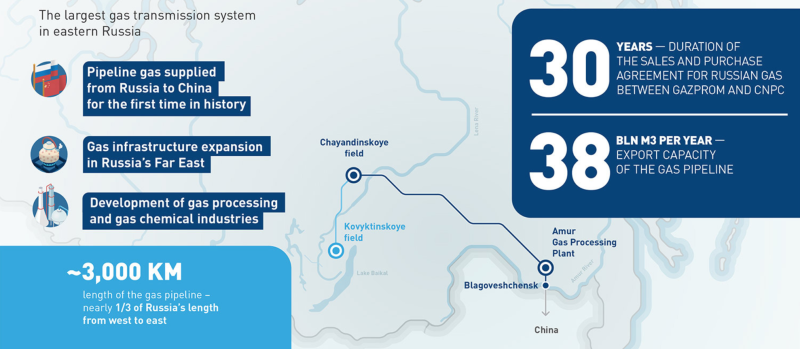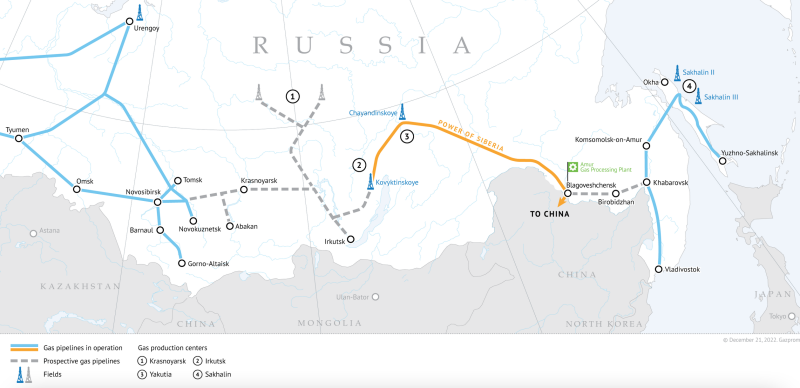Russia and China are nearing agreement on a 2024 construction start for the long-discussed 6700 km Power of Siberia 2 (PoS2) pipeline that would deliver Russian gas from West Siberia, previously designated for European export, to industrial areas north of Beijing via Mongolia by 2030.
The proposed pipeline’s 50 Bcm/year capacity nearly matches that of the 55 Bcm/year Nord Stream 1 which had carried a third of Russian gas deliveries to the EU before being shut down in September. Once built, PoS2 would double Russia’s current gas exports to China as it would join up with the Russian gas network that connects to the Yamal Peninsula (West Siberia), enabling Russia to direct gas to markets east or west at will.
After 3 days of talks in Moscow with Chinese President Xi Jinping in March, Russia’s President Vladimir Putin announced that “nearly all parameters” have been decided to proceed with PoS2. Authorities anticipate a 2024 construction start.
“The total volume of (Russian) gas supplies by 2030 (to China) will be at least 98 Bcm/year, plus 100 million tons of liquefied natural gas (LNG),” the Interfax news agency quoted the Russian president as saying during the week he met with Xi.
Moscow and Beijing have debated a trans-Mongolia gas pipeline since at least 2006 but they could never agree on a price for the gas; Russia had no incentive to flip its lucrative European business east unless China sweetened the price.
So, Gazprom built the Nordstream 1 and 2 systems to maximize Yamal gas exports to Europe, while in the east, it launched the state-run Eastern Gas Development Program in 2007 to target the Chinese market with an integrated gas production, transportation, and supply system joining resource bases in Eastern Siberia, Power of Siberia 1 (PoS1), and the Far East, Power of Siberia 3 (PoS3).
Now however, PoS2 will have to come off the back burner and add its 50 Bcm potential throughput to support Russia’s pivot east and meet Putin’s goal. In July, Mongolia’s Prime Minister Oyun-Erdene Luvsannamsrai told the Financial Times that a feasibility study had been completed but the exact route of PoS2 remained under discussion.
Planners had earlier envisioned a pipeline crossing the Altai mountains to join gas fields in West Siberia with those in the oil-rich Xinjiang Uygur Autonomous Region in northwest China. In September 2019, however, China expressed a preference for a route that would pass from Irkutsk through Mongolia to Beijing.
Shunned by the West, Russian Gas Flows East at Historic Levels
In 2022, Gazprom exported a record 15.5 Bcm of gas to China through PoS1, a 49% increase over 2021 deliveries, Russia’s Vedomosti business media reported, quoting Deputy Prime Minister Alexander Novak.
Gazprom and the China National Petroleum Corp. (CNPC) have signed two separate 30-year contracts for delivery of Russian gas. The first, signed in May 2014, obligates Gazprom to supply 38 Bcm/year of Russian gas to China (deliveries began when PoS1 shipped its first gas in December 2019). The second, signed in February 2022, commits to 10 Bcm/year and is euro-based. Reuters reported at the time that deliveries (via PoS3) on the second contract would begin by 2025.
Chinese customs data published on 20 March confirmed the trend toward Russia’s establishing itself as Beijing’s No. 1 gas supplier. Vedomosti observed that “the Chinese side's bid for the supply of Russian gas through the Power of Siberia 1 gas pipeline significantly exceeded daily contractual obligations. Gazprom delivered the requested volumes and set a new historical record for daily gas supplies to China” in the first months of 2023.
In January, Russia displaced Turkmenistan, Qatar, and Australia to become China’s No. 1 gas supplier, exporting over 2.7 Bcm of which 2 Bcm arrived via the PoS1, and 0.77 Bcm that was delivered as LNG. The same month, Turkmenistan, and Qatar each delivered 2.2 Bcm, while Australia supplied 1.9 Bcm, Vedomosti reported, quoting Chinese customs data. In 2023, Gazprom expects to export 22 Bcm via PoS1.

PoS1 Fuels New Geopolitical Alignments
Commissioned in 2019, PoS1 is on track to reach its nameplate capacity of 38 Bcm/year by 2025 and deliver Russian gas as far as Shanghai, as new transmission lines are progressively added, new gas resources tapped, and gas processing capacities increased. In mid-March, Gazprom published the following benchmarks it plans to achieve in 2023.
- Construction of key infrastructure at the Chayandinskoye field in Yakutia including the gas pretreatment unit (GPTU-4) and new production wells to reach full-field capacity in 2024.
- Completing a second gas pretreatment unit (GPTU-3), new production wells, and construction on the central booster compressor station at the existing GPTU-2 at the Kovyktinskoye field in Irkutsk.
- Raising the throughput capacity of the PoS1 gas trunkline in tandem with the increase in production capacities. This entails continued construction on the loopings (pipeline segments that are laid parallel to the main pipeline string) at the gas pipeline section from the Chayandinskoye field to Blagoveshchensk. So far, 578 km (39% of the design length) of the pipelines are in place. Gazprom also plans to build second compressor workshops at several active compressor stations in 2023.
- Continuation of construction on the Amur gas processing plant which is already 88.5% complete and will process multicomponent gas from the Chayandinskoye and Kovyktinskoye fields.
- Continued development of the Sakhalin gas production center including expansion of the capacity of the Sakhalin-Khabarovsk-Vladivostok gas trunkline plus further development of the Kirinskoye field offshore Sakhalin, the designated resource to feed the PoS3.

Russia’s Eastern Gas Program Integrating Pipeline Networks From Yamal to Sakhalin

Russia Isn’t Short on Liquids Either
Meanwhile, China increased imports of LNG from Russia to 590,400 tons this February. The figure represented a 50% increase over the same month a year ago, Chinese customs data also revealed. China’s imports of Russian LNG rose 37% in January 2023 compared to last year.
Regarding crude oil, China's crude oil imports from Russia surged to a record high of 2.01 million B/D in February, a roughly 20% share of the market, the data showed. Russian crude deliveries surged 42% year on year and were 33.1% higher than shipments from second-largest supplier Saudi Arabia which supplied 1.51 million B/D, according to the Chinese data.
In an article posted on 23 March on its website, Wood Mackenzie projected that China will “account for 1 million B/D of the 2.6 million B/D gain” in oil demand expected in 2023 now that the country has ended its zero-COVID 19 policy. Woodmac noted that China’s LNG imports (have grown) for the first time in 13 months,” a development that could shift deliveries away from Europe.


